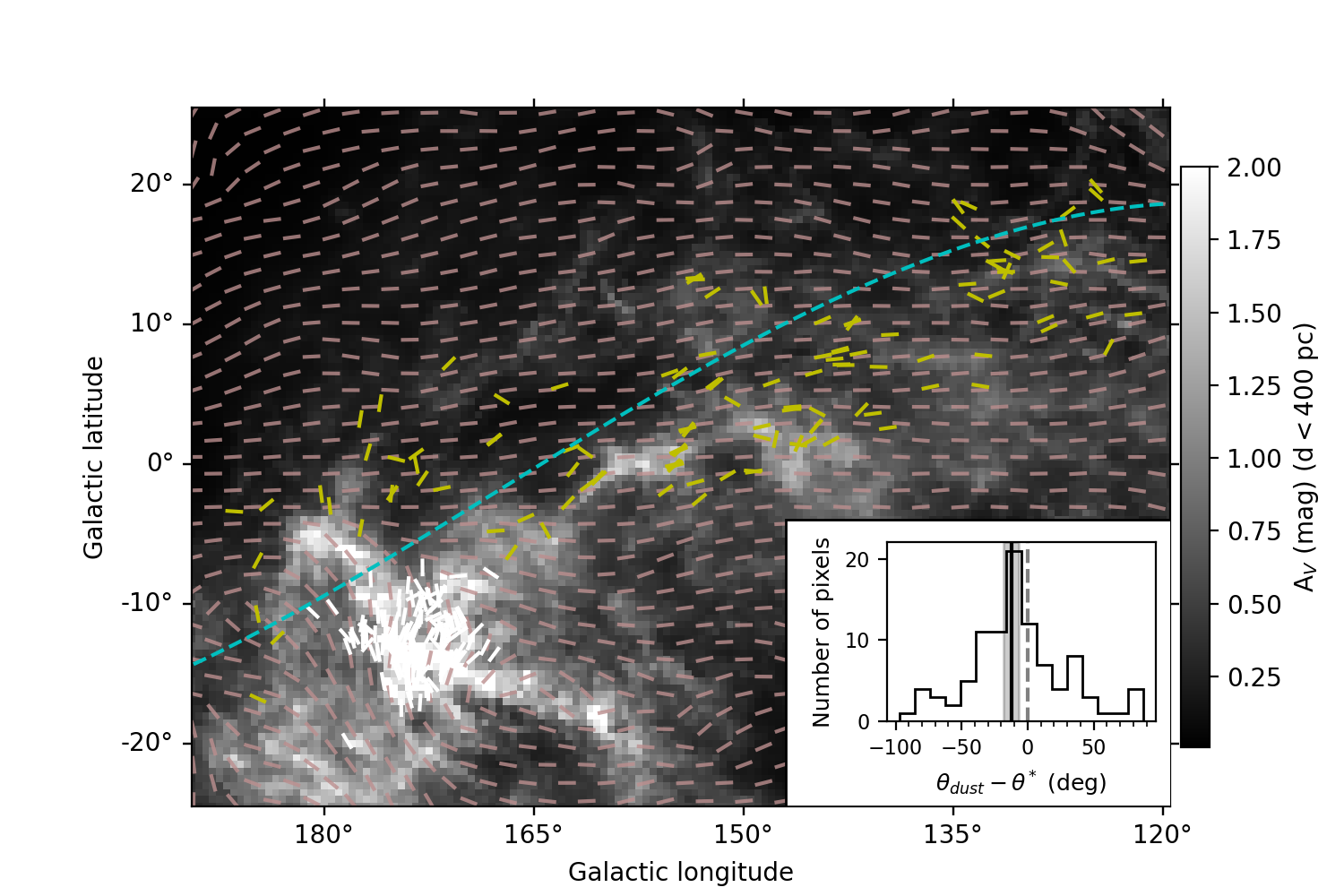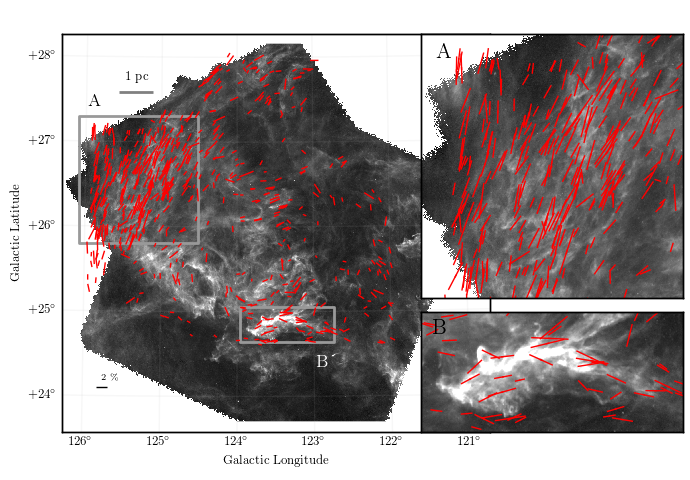Gina Panopoulou's research group
Home About Group Projects Publications Code/Data Outreach
Up-to-date list of Gina's publications can be found on the NASA ADS webpage at this location.
Contents
- A new compilation of stellar polarization catalogs for ISM studies
- Mapping the magnetic field of the Radcliffe Wave
- Improved CMB foreground modeling
- Understanding ISM dust properties
- Optopolarimetric mapping of molecular clouds
- Properties of filamentary structures in molecular clouds
A new compilation of stellar polarization catalogs
Stellar polarization is a unique tool for mapping the Galactic magnetic field and understanding the properties of interstellar dust. Despite their importance, stellar polarimetry measurements are sparse and difficult to find. Observations are conducted by different investigators, with different instruments and are made available in many separate publications. To enable a more widespread accessibility of optical polarimetry for studies of the interstellar medium, we compiled a new catalog of stellar polarization measurements. The data are gathered into a single, homogeneous format from 81 separate publications, representing a community effort of two decades. We combine this invaluable dataset with stellar distances from the Gaia mission, enabling new 3D studies of the magnetized ISM.

Related publication:
Mapping the magnetic field of the Radcliffe Wave
The nearest spiral arm to the Sun, known as the Local Arm, hosts a multitude of molecular clouds. These clouds form a peculiar linear structure of ~3 kpc length that appears to oscillate up and down the Galactic plane - the Radcliffe Wave. Little is known about the properties and origin of this structure, but more work is being done to collect more information. We combined new NIR stellar polarization data towards the Radcliffe Wave with archival starlight polarizations to measure the magnetic field geometry of this structure as projected on the sky. Interestingly, we find that the magnetic field is tilted with respect to the Galactic plane, following the projected shape of the structure on the sky.

Related publication:
Improved CMB foreground modeling
The Galactic magnetic field interacts with interstellar dust and cosmic rays and produces broadband emission from radio to infrared wavelengths. This emission is polarized and acts as a confusing foreground to light from the early Universe, known as the Cosmic Microwave Background (CMB). To study the pristine light of the CMB, we must accurately model and subtract the signal from our Milky Way. A large effort is underway to improve such models by incorporating 3D information about the ISM and its magnetic field.

Related publications:
- G. V. Panopoulou & D. Lenz, "Maps of the Number of H I Clouds along the Line of Sight at High Galactic Latitude", ApJ, 2020
- V. Pelgrims et al., "Evidence for line-of-sight frequency decorrelation of polarized dust emission in Planck data", A&A, 2021
- G. Puglisi et al., "Improved galactic foreground removal for B-mode detection with clustering methods", MNRAS, 2022
Understanding ISM dust properties
Combining measurements of polarized dust emission with those of starlight polarization, we can learn about the physics of dust grains in the ISM.
Related publication:
Optopolarimetric mapping of molecular clouds
The ISM contains clouds, mainly made up of molecular hydrogen, that are the sites where stars form. The details of this formation process are a subject of active academic research. One aspect of this process is the influence of the magnetic field on the structure and evolution of these clouds. We study this by measuring the polarization of starlight, which reveals the orientation of the magnetic field in molecular clouds. With enough measurements, one can construct a map of the magnetic field as seen on the plane of the sky. Figure 1 shows a map of the magnetic field orientation (red lines) in the Polaris Flare molecular cloud, made using the RoboPol polarimeter at the Skinakas observatory in Greece. The magnetic field structure can be compared to the intricate filamentary morphology of the cloud, seen through the Herschel space telescope in the far infrared, to learn about the influence of the magnetic field on cloud structure. The Polaris Flare polarization data are publicly available.

Related publications:
- G. V. Panopoulou et al., "Optical polarization map of the Polaris Flare with RoboPol", MNRAS, 2015
- G. V. Panopoulou, I. Psaradaki, K. Tassis, "The magnetic field and dust filaments in the Polaris Flare", MNRAS, 2016
Morphology & kinematics of filamentary structures in molecular clouds
Through observations of the emission from dust in molecular clouds, the Herschel Space Telescope revealed that cloud material is organized in a network of filamentary structures. The properties of these structures are very interesting, as they can help us understand how they form and evolve.
Another interesting aspect of the process leading to star formation is the manner in which gas moves inside a cloud, a motion that is highly
complex (turbulent). One can use emission line data from molecules like CO, which exist in minuscule fractions in molecular clouds, to trace one of the 3
components of the gas velocity, the component that lies along the line of sight. Gina has used such radio data from the NRAO
taken in the region of the Taurus molecular cloud, to study the kinematics of filamentary structures. Gina developed
Related publications:
- G. V. Panopoulou et al., "The width of Herschel filaments varies with distance", A&A, 2022
- G. V. Panopoulou, I. Psaradaki, R. Skalidis, K. Tassis, J. J. Andrews, "A closer look at the 'characteristic' width of molecular cloud filaments", MNRAS, 2017
- G. V. Panopoulou, K. Tassis, P. F. Goldsmith, M. Heyer, "13CO filaments in the Taurus molecular cloud", MNRAS, 2014